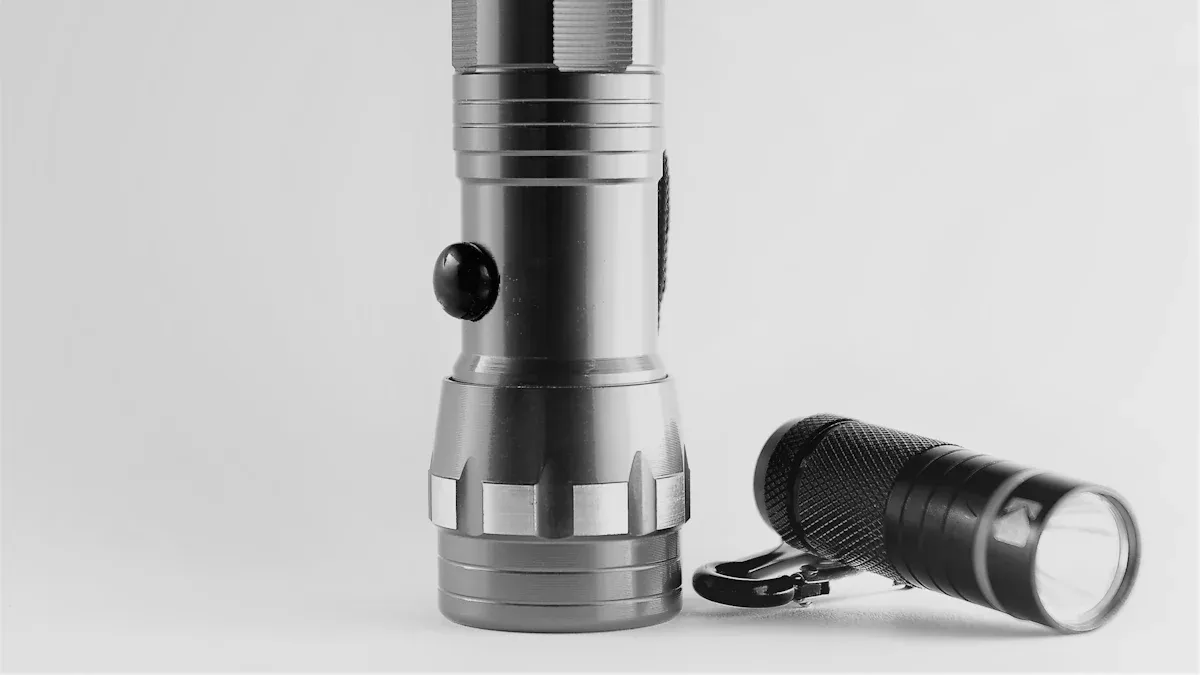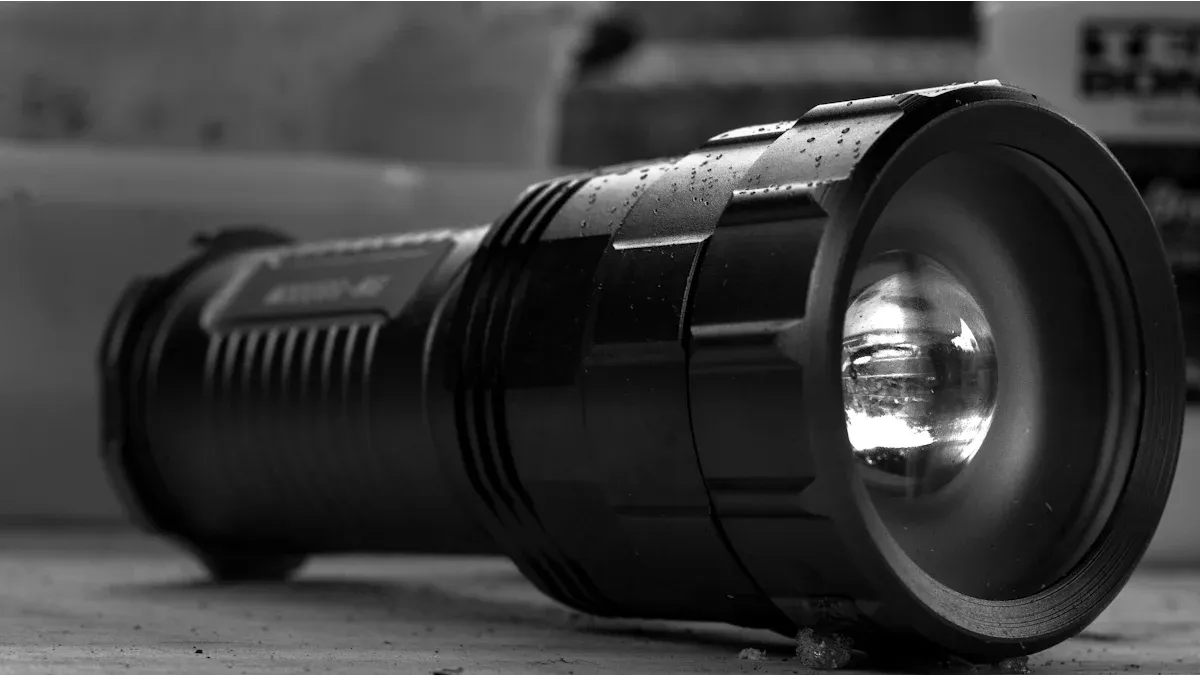Understanding flashlight using lumens for daily use

When you think about a flashlight using its brightness, that is probably the first thing that comes to mind. That brightness is measured in lumens. Understanding lumens helps you pick the right flashlight for your needs. Whether you’re lighting up a room or heading outdoors, matching lumens to your task ensures safety and efficiency.
Key Takeaways
Lumens show how bright a flashlight is. More lumens mean brighter light, helping you pick the best flashlight for your needs.
For daily use, choose flashlights with 1-300 lumens. This amount works well for reading, walking at home, or simple outdoor tasks.
Think about how you will use the flashlight. Pick the right lumens for your activities to stay safe and use it well.
What are lumens, and why do they matter for flashlight using?

Definition of lumens and their role in flashlight brightness
Lumens measure the total amount of visible light a flashlight produces. Think of it as the "brightness" you see when you turn on the flashlight. The higher the lumens, the brighter the light. Unlike other units like candela or lux, lumens focus on the overall light output rather than beam intensity or direction. Here's a quick comparison:
Measurement Unit | Description |
|---|---|
Lumens | Measures total brightness of a flashlight |
Candelas | Focuses on beam intensity and throw |
In simple terms, lumens tell you how much light your flashlight can produce, making it easier to choose the right one for your needs.
How lumens impact flashlight performance
The number of lumens directly affects how well a flashlight performs in real-world situations. For example:
Intended use: A flashlight for camping may need more lumens than one for reading at home.
Environmental conditions: Low-light areas require higher lumens, while well-lit spaces need less.
Personal preferences: Some people prefer softer light, while others want maximum brightness.
Keep in mind that higher lumens often mean shorter battery life. A flashlight with 1000 lumens will drain its battery faster than one with 300 lumens. So, balance is key.
Why lumens are crucial for choosing the right flashlight
Understanding lumens helps you pick a flashlight that fits your specific tasks. For everyday use, 150-500 lumens work well. Outdoor activities like hiking might need 1000-3000 lumens, while professional tasks such as search and rescue often require over 3000 lumens. Knowing this ensures you don’t end up with a flashlight that's too dim or unnecessarily bright.
Additionally, being informed about lumens can save you from common mistakes. For instance, don’t get misled by marketing terms like "tactical." Instead, focus on the actual lumen output and how it matches your needs. This way, you’ll make a smarter choice and get the most out of your flashlight.
How many lumens are needed for daily flashlight using?

1-100 lumens: Basic home and everyday tasks
For simple tasks like reading or finding items in a drawer, flashlights with 1-100 lumens are perfect. They provide just enough light without being overwhelming. For example, if you're reading at night, a flashlight with around 50 lumens offers sufficient brightness while being gentle on your eyes. These low-lumen flashlights are also ideal for navigating your home during a power outage.
Here’s a quick guide to recommended lumens for different rooms:
Room Type | Recommended Lumens per Square Foot |
|---|---|
Living rooms | 5-20 |
Bedrooms | 5-15 |
Kitchens | 30-50 |
Bathrooms | 15-30 |
Home office | 30-50 |
This range works well for everyday carry flashlights, as they’re compact and energy-efficient.
100-300 lumens: Indoor use and light outdoor activities
Flashlights in the 100-300 lumen range are versatile. They’re great for indoor tasks like navigating dark hallways or outdoor activities such as night walks. These flashlights balance brightness with battery life, making them practical for most situations. For example, during an emergency or power outage, 200 lumens provide enough light to move around safely without draining the battery too quickly.
Advantages of this range include:
Lightweight and easy to carry.
Suitable for both indoor and outdoor use.
Provides ample brightness for routine activities like reading or locating items.
300-1000 lumens: Camping, hiking, and nighttime use
If you’re into camping or hiking, flashlights with 300-1000 lumens are your go-to. They offer high output for tasks like cooking at the campsite or navigating trails in the dark. For instance, a flashlight with 500 lumens is perfect for camping, while 400 lumens work well for hiking trails. These flashlights often feature adjustable brightness, allowing you to conserve battery life when needed.
Safety features in this range include:
Safety Feature | Description |
|---|---|
Adjustable Brightness | Lets you switch between lumen levels for different tasks. |
Beam Distance | Provides visibility over longer distances, reducing hazards. |
Adjustable Focus | Offers flexibility between floodlight and spotlight modes. |
1000+ lumens: Tactical, professional, and search-and-rescue needs
For demanding tasks, you’ll need a powerful flashlight with 1000+ lumens. Tactical flashlights in this range are essential for professionals like law enforcement officers or search-and-rescue teams. They can illuminate areas over 500 meters, making them ideal for searching in extreme conditions. Hunters and security guards also rely on these high-lumen flashlights for their intense brightness and long beam distance.
However, these flashlights aren’t suitable for everyday tasks. Using a 10,000-lumen flashlight indoors can be excessive and even uncomfortable. They also drain batteries quickly and generate significant heat, so they’re best reserved for specific scenarios.
How to decide the lumens for your flashlight
Identifying your primary use case
The first step in choosing the right flashlight is understanding how you’ll use it. Ask yourself a few key questions:
What are your primary use cases for the flashlight?
Do you need long-range visibility or wide-area coverage?
Are you willing to compromise on portability for brightness?
Your answers will guide you toward the ideal lumen range. For example, if you’re hiking at night, you’ll need 1000-2000 lumens to safely navigate trails. On the other hand, a flashlight with 150-300 lumens is perfect for night walks or reading at night. Here’s a quick reference table to help you match lumens to specific tasks:
Use Case | Recommended Lumens | Description |
|---|---|---|
Hiking | 1000-2000 | Provides ample light for trails and obstacles, ensuring safety during night hikes. |
Night Walks | 150-300 | Sufficient light to see paths and avoid hazards, lightweight and easy to carry. |
Law Enforcement Patrols | 800-1000 | Effective illumination in dark environments, balancing brightness and battery life. |
Search and Rescue | 3000-7000 | Powerful searchlights that illuminate areas over 500 meters away, critical for locating individuals. |
Industrial Worksites | 1000-3000 | Robust lighting solutions that improve safety and efficiency on construction sites. |
Considering flashlight size, battery life, and features
When selecting a flashlight, size and battery life matter just as much as lumens. A compact flashlight is easier to carry but may have lower brightness. If you need a tactical flashlight for outdoor or emergency use, look for one with adjustable brightness and a long-lasting battery. Features like beam distance and weather resistance can also make a big difference. For example, higher lumens (1000-3000) perform better in rain or fog, while adjustable brightness ensures you can conserve battery life when needed.
Balancing brightness, practicality, and cost
Finding the right balance between brightness and cost is crucial. Think about your environment and activities. Do you need a flashlight for camping, searching, or everyday tasks? Higher lumens are great for low-light conditions, but they often come with a higher price tag and shorter battery life. On the other hand, lower lumens work well in well-lit areas and are more budget-friendly. Choosing the right flashlight involves considering factors like lumen count, runtime, and battery specifications. This personalized approach ensures you get the best value without compromising on practicality.
Tip: Don’t just focus on the lumen count. Look at the overall features and how they fit your needs.
Understanding lumens is key to choosing the right flashlight for your needs. Matching lumen ranges to tasks, like using 1-300 lumens for reading or 300-1000 lumens for night walks, ensures efficiency. Always consider your environment and preferences. By assessing your unique needs, you’ll find a flashlight that balances brightness and practicality.
FAQ
How do I know if a flashlight is too bright for indoor use?
Flashlights with over 1000 lumens can feel too bright indoors. Stick to 100-300 lumens for comfortable and practical lighting inside your home.
Can a flashlight with high lumens damage my eyes?
Yes, prolonged exposure to flashlights with very high lumens can strain or damage your eyes. Avoid staring directly into the beam, especially at close range.
What’s the best flashlight for camping?
For camping, choose a flashlight with 300-1000 lumens. It provides enough brightness for tasks like cooking, setting up tents, or navigating trails at night.
See Also
A Complete Guide to Understanding Flashlight Lumens
Exploring 1000 Lumens: The Science of Brightness
The Basics of Stepless Dimming for Flashlights
